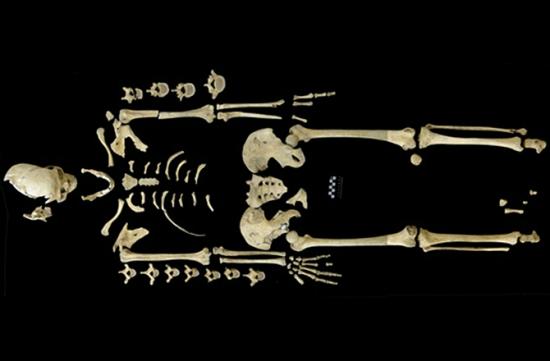Rossella Lorenzi
Source - http://news.discovery.com/history/archaeology/oldest-case-of-leukemia-found-on-7000-year-old-skeleton-150818.htm
 The Neolithic skeleton affected by leukemia. UNIVERSITY OF TÜBINGEN
The Neolithic skeleton affected by leukemia. UNIVERSITY OF TÜBINGEN
German researchers have discovered what might be the earliest case of leukemia in a 7,000-year-old skeleton, they announced at the first European conference on evolutionary medicine.
Belonging to a female individual who died at 30-40 years, the skeleton was excavated in 1982 among other 72 burials at an early Neolithic site near Stuttgart-Mühlhausen in south western Germany.
Beside the individual stood a round-bottomed jar. The site was linked with the Linear Pottery culture, an early farming culture which flourished in western and central Europe between 5500–4800 BC and produced pottery with distinctive linear decorations.
“So far only a severe case of dental caries with alveolar inflammation was reported for this individual,” team leader Heike Scherf, from the Senckenberg Center for Human Evolution and Paleoenvironment at the University of Tübingen in Germany, said.
Using high resolution CT scans, Scherf and colleagues found a pattern of deep loss of spongy bone in both the bone tissue of the humerus (the long bone that runs from the shoulder to the elbow) and the sternum, or breastbone.
According to the researchers, the resorption of central spongy bone is significantly higher compared to specimens of the same age group from the same site and to recent human samples of the adult age class.
“Our results strongly suggests leukemia in its initial stages, affecting the hematopoietic stem cells in bone marrow,” Scherf said.
The locally restricted destruction of the sternum and humerus’s bone tissue ruled out other diseases such as osteoporosis, hyperparathyroidism and bone tumor.
“A virus associated with a special type of leukemia (T-cell leukemia) was previously found in Andean mummies. But this case is probably the earliest known appearance of leukemia in an archeological case,” Scherf told Discovery News.
The researchers admitted it’s impossible to make any more detailed assumptions, such as establishing the type of leukemia that affected the Neolithic woman.
Diseases That Just Won't Quit
Frank Rühli, director of the Institute of Evolutionary Medicine at the University of Zurich, where the conference took place, found the study interesting.
“Based even on such state-of-the-art imaging, one can never be 100 percent sure about such a paleopathological finding,” Rühli told Discovery News.
“That said, to have an indication for the oldest paleopathological record of a modern, frequent disease with a major impact such as leukemia is very important from the perspective of the evolution of the disease,” he added.